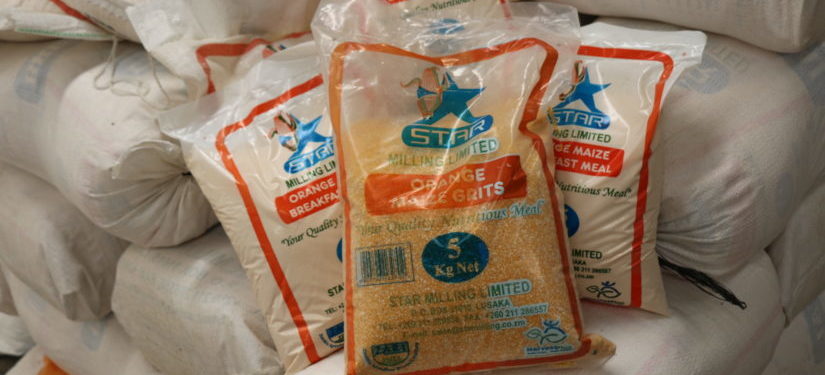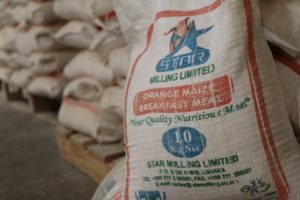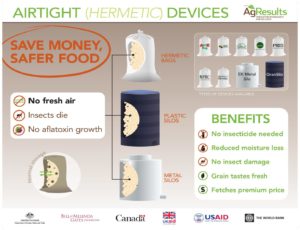Expert Analysis
by Hannah Guedenet & Andrew Gathecha

At Tanager, we are constantly monitoring our co-created projects and using those learnings to improve upon our work. Below, Tanager experts Hannah Guedenet and Andrew Gathecha examine the factors that determined the success of two AgResults pilot programs.
From 2015 to 2018, Tanager implemented two AgResults pilot programs – the Kenya On-Farm Storage pilot and the Zambia Biofortified Maize pilot. In Kenya, we partnered with storage device manufactures to market and sell large volumes of storage devices to smallholder farmers in the Rift Valley and Eastern regions of Kenya. In Zambia, the pilot incentivized seed companies to sell provitamin A-rich (PVA) “orange” maize seed to farmers and commercial millers to sell PVA maize meal to consumers.
Through these experiences, we gained three valuable insights into what works and what doesn’t in a pay-for-results model.
 First – Government engagement can either help or hinder pay-for-results initiatives and is important to consider during program design and start-up. In Kenya, we needed time to build government buy-in about the value proposition of a market mechanism to deliver development objectives. After many conversations and seeing the results on the ground, government representatives shifted their mindset from traditional ‘patronage’, push-type developmental model, and began to appreciate and support the pull strategy where the private sector could approach farmers as rational economic actors willing to invest in technologies to protect their food security
First – Government engagement can either help or hinder pay-for-results initiatives and is important to consider during program design and start-up. In Kenya, we needed time to build government buy-in about the value proposition of a market mechanism to deliver development objectives. After many conversations and seeing the results on the ground, government representatives shifted their mindset from traditional ‘patronage’, push-type developmental model, and began to appreciate and support the pull strategy where the private sector could approach farmers as rational economic actors willing to invest in technologies to protect their food security
On the other hand, government regulation can complicate pay-for-results efforts. In Zambia, working directly with a staple food commodity such as maize proved to be challenging. Although we successfully advocated for the government to include PVA maize into its maize stock program, a government-issued export ban on the sale of milled maize and price-fixing affected market prices for maize. This steady government interference made it difficult for millers to buy PVA maize and sell it as meal to the consumer market.
Second – When you design a pay-for-results model, you must identify the right point in the value chain and the right actors for the greatest impact.
In particular, donors or practitioners should select a product that responds to consumers’ perceived or immediate unmet needs. In Kenya, smallholder farmers were long hamstrung by largely inefficient, scarcely available storage solutions, therefore the impact of post-harvest loss was acutely felt. After only a few months using the improved hermetic devices promoted by the project, the farmers saw the positive effects and enthusiastically embraced the technology.
In Zambia, however, end consumers were less convinced of the need to eat more vitamin A. While orange nshima or porridge tastes good, the positive health effects were not so readily apparent.
Designers should also ensure that target actors involved in selling or promoting the product in the PfR model are connected to the intended buyers of the product. In the original Zambia model, the maize millers identified as key implementers did not have direct contact with consumers. Instead, the millers’ primary relationship was with retail outlets that then sold to consumers, so they had limited experience marketing their brand or product to consumers.
 The model was eventually adapted to include seed companies that were selling directly to farmers who grew orange maize. This direct approach proved to be a more successful entry point for increasing the supply of PVA maize. An alternative approach would have been engaging retail outlets who interact directly with consumers and have experience building demand for products.
The model was eventually adapted to include seed companies that were selling directly to farmers who grew orange maize. This direct approach proved to be a more successful entry point for increasing the supply of PVA maize. An alternative approach would have been engaging retail outlets who interact directly with consumers and have experience building demand for products.
Third – Behavior change analysis should inform whether a pull mechanism is sufficient to change end user behavior, or if the behavior change will require more traditional “push” interventions. A big challenge that we faced with orange maize was that the pilot required a significant amount of behavior change on the part of the end consumer: Zambian consumers have always eaten white maize. Their association with yellow maize comes from a history of receiving it as food aid in the 1990s. This resulted in consumers believing PVA maize was subpar and associated to cattle feed.
In the end in Zambia, prize money totaling more than $600,000 was awarded to two seed companies that surpassed the sales thresholds for PVA maize seed. No milling implementers reached the sales performance targets.
 In the case of Kenya, a total of $6.25 million in performance-based grants were awarded to private sector companies. This investment changed behaviors – dramatically increasing smallholder farmers’ use of hermetic devices and their awareness of the technology. More than 300,000 smallholder farmers in Kenya’s Eastern and Rift Valley regions adopted the technology, creating 413,000 MT of improved storage. This equates to roughly 4.6 million 90-kg bags of maize that was saved from pests and other loss. We estimate that the value of post-harvest loss averted as a result of the project is between 1.4-2.3 billion Kenyan shillings, or 14-23 million USD. This project demonstrates how farmers will invest in innovative, effective, and affordable technologies when these technologies are readily available.
In the case of Kenya, a total of $6.25 million in performance-based grants were awarded to private sector companies. This investment changed behaviors – dramatically increasing smallholder farmers’ use of hermetic devices and their awareness of the technology. More than 300,000 smallholder farmers in Kenya’s Eastern and Rift Valley regions adopted the technology, creating 413,000 MT of improved storage. This equates to roughly 4.6 million 90-kg bags of maize that was saved from pests and other loss. We estimate that the value of post-harvest loss averted as a result of the project is between 1.4-2.3 billion Kenyan shillings, or 14-23 million USD. This project demonstrates how farmers will invest in innovative, effective, and affordable technologies when these technologies are readily available.
These two examples illustrate important levers to consider when designing a pay-for-results program to introduce new products to markets. Based on our experience, we urge stakeholders to consider the following when designing pay-for-results programs: Is the policy environment conducive to the product you are trying to promote through market incentives? Are your targeted actors going to have the greatest influence in changing the behaviors of end users? Will the product address a consumer’s perceived need? What behaviors are you asking people to change and is it a bridge too far?
 Hannah Guedenet has more than 10 years of experience in health, nutrition, and strategic communications. As Tanager’s lead on our nutrition-sensitive agriculture portfolio, she provides technical leadership and project management to translate agricultural gains into better nutrition for households and communities.
Hannah Guedenet has more than 10 years of experience in health, nutrition, and strategic communications. As Tanager’s lead on our nutrition-sensitive agriculture portfolio, she provides technical leadership and project management to translate agricultural gains into better nutrition for households and communities.
 Andrew Gathecha has more than 15 years of experience in agriculture, health, education, and media sectors. As Tanager’s team leader for the AgResults Kenya On-Farm Storage Pilot project, he managed an innovative effort using “pull mechanisms” to reduce post-harvest loss of grain. Previously, he connected farmer organizations, exporters, agribusinesses, government departments, and NGOs to co-design and implement agricultural interventions for 12 different crops that reached more than 250,000 households.
Andrew Gathecha has more than 15 years of experience in agriculture, health, education, and media sectors. As Tanager’s team leader for the AgResults Kenya On-Farm Storage Pilot project, he managed an innovative effort using “pull mechanisms” to reduce post-harvest loss of grain. Previously, he connected farmer organizations, exporters, agribusinesses, government departments, and NGOs to co-design and implement agricultural interventions for 12 different crops that reached more than 250,000 households.

